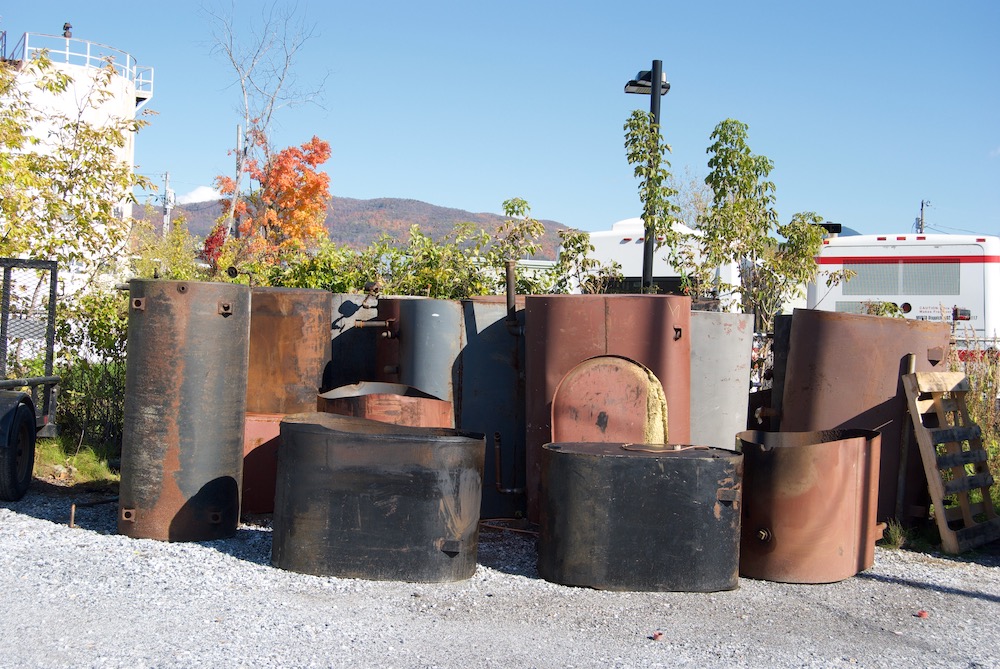I just replaced my original steel oil tank from 1958 with a 275 gallon Roth. I went with the Roth as the inner tank is plastic and impervious to corrosion, acid, rust, etc. I mainly use my mini splits for heat as I have enough net metered solar to run them pretty much the entire winter. The oil furnace really only runs in the rare polar vortex cold and to occasionally run the humidifier on it. It's going to take me years most likely before I need a fill.
Anyone know how long fuel oil will stay good in a plastic tank? Should I look into an additive?
Here are a few pictures. Really impressed with this tank. The biggest thing I like is its compact size. Takes up way less room than the old steel tank. The outer stainless shell can contain 110% of the inner plastic tank as well. It also came with a 2 million insurance cleanup policy. Its being feed by a single over head line with a tiger loop ultra with a 10 micron spin on filter. Cost me $2500 and permits were pulled and it was inspected.
![[Hearth.com] Just had a Roth oil tank installed. Long term fuel oil storage? [Hearth.com] Just had a Roth oil tank installed. Long term fuel oil storage?](https://www.hearth.com/talk/data/attachments/269/269084-a4550b0418b58c91e487f028733a2338.jpg?hash=wIGAedaUmL)
![[Hearth.com] Just had a Roth oil tank installed. Long term fuel oil storage? [Hearth.com] Just had a Roth oil tank installed. Long term fuel oil storage?](https://www.hearth.com/talk/data/attachments/269/269085-d1501f13bbdaad15ab0708ffa37bc45f.jpg?hash=ENhf0ctx1a)
![[Hearth.com] Just had a Roth oil tank installed. Long term fuel oil storage? [Hearth.com] Just had a Roth oil tank installed. Long term fuel oil storage?](https://www.hearth.com/talk/data/attachments/269/269086-62bcf1451e6056f785547ce628632698.jpg?hash=1DOk9sSbsT)
Anyone know how long fuel oil will stay good in a plastic tank? Should I look into an additive?
Here are a few pictures. Really impressed with this tank. The biggest thing I like is its compact size. Takes up way less room than the old steel tank. The outer stainless shell can contain 110% of the inner plastic tank as well. It also came with a 2 million insurance cleanup policy. Its being feed by a single over head line with a tiger loop ultra with a 10 micron spin on filter. Cost me $2500 and permits were pulled and it was inspected.
![[Hearth.com] Just had a Roth oil tank installed. Long term fuel oil storage? [Hearth.com] Just had a Roth oil tank installed. Long term fuel oil storage?](https://www.hearth.com/talk/data/attachments/269/269084-a4550b0418b58c91e487f028733a2338.jpg?hash=wIGAedaUmL)
![[Hearth.com] Just had a Roth oil tank installed. Long term fuel oil storage? [Hearth.com] Just had a Roth oil tank installed. Long term fuel oil storage?](https://www.hearth.com/talk/data/attachments/269/269085-d1501f13bbdaad15ab0708ffa37bc45f.jpg?hash=ENhf0ctx1a)
![[Hearth.com] Just had a Roth oil tank installed. Long term fuel oil storage? [Hearth.com] Just had a Roth oil tank installed. Long term fuel oil storage?](https://www.hearth.com/talk/data/attachments/269/269086-62bcf1451e6056f785547ce628632698.jpg?hash=1DOk9sSbsT)
Last edited:



![[Hearth.com] Just had a Roth oil tank installed. Long term fuel oil storage? [Hearth.com] Just had a Roth oil tank installed. Long term fuel oil storage?](https://www.hearth.com/talk/data/attachments/269/269457-811bfd35dbe701a21bfc0f979fa5b8d7.jpg?hash=pr901kq0rW)
![[Hearth.com] Just had a Roth oil tank installed. Long term fuel oil storage? [Hearth.com] Just had a Roth oil tank installed. Long term fuel oil storage?](https://www.hearth.com/talk/data/attachments/269/269462-b897f6a27c26ac01cbeae69f6a4448e0.jpg?hash=U37mTmlppP)
![[Hearth.com] Just had a Roth oil tank installed. Long term fuel oil storage? [Hearth.com] Just had a Roth oil tank installed. Long term fuel oil storage?](https://www.hearth.com/talk/data/attachments/269/269463-a7300dc895f6d7deb1af40227b93097d.jpg?hash=oUIRpcfOCr)